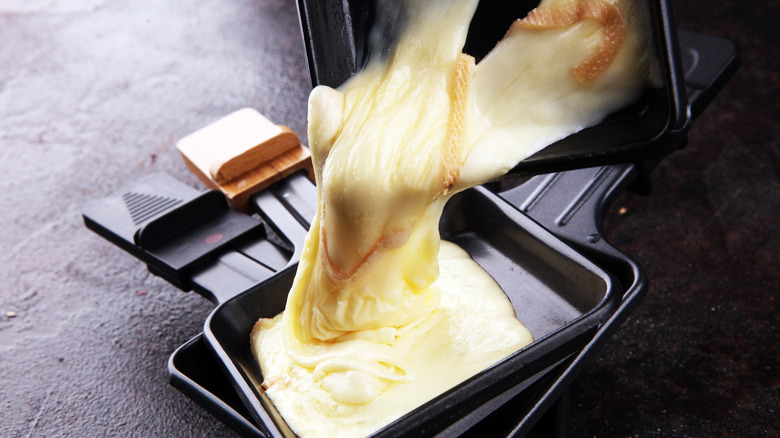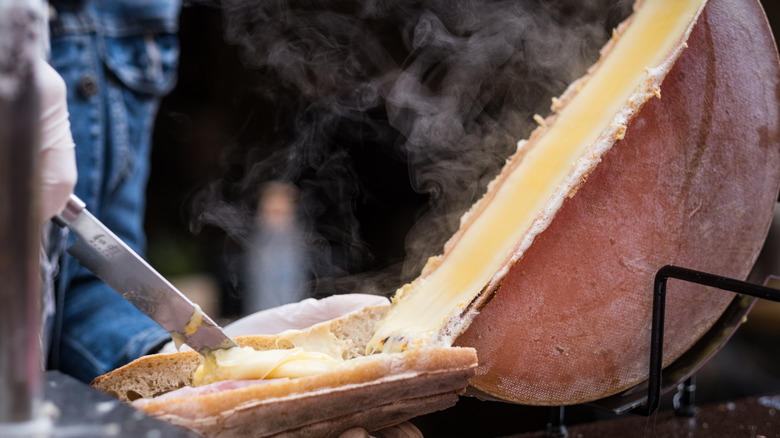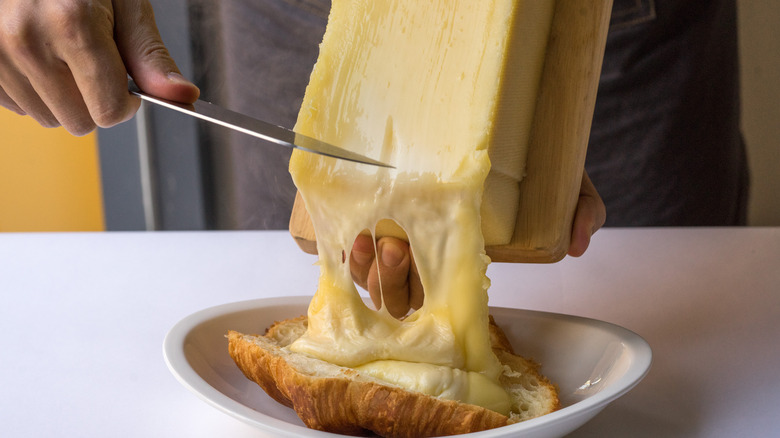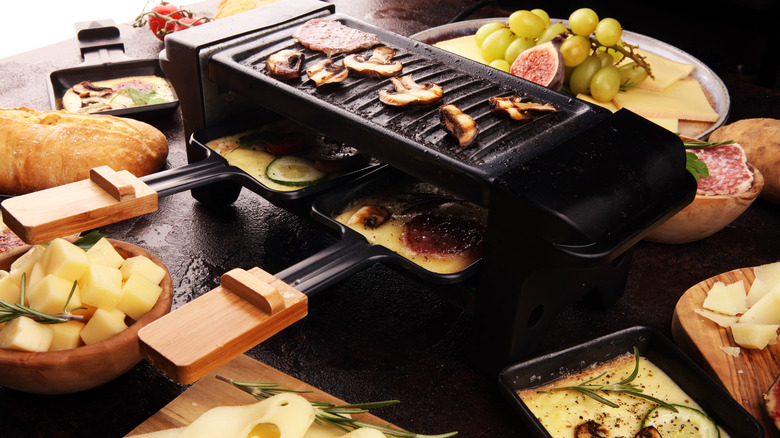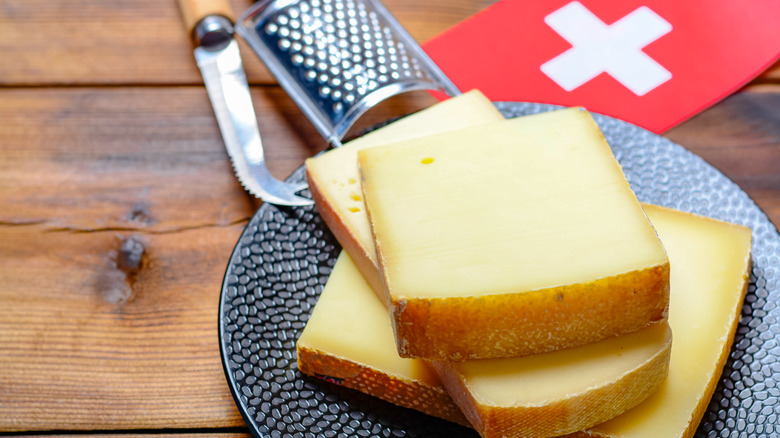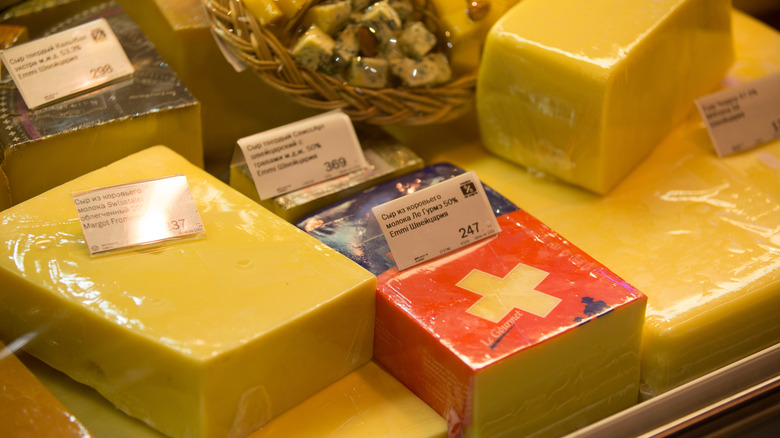What Is Raclette Cheese And How Do You Eat It?
Perhaps you've heard of raclette cheese, perhaps not. But if you're just tuning in, be prepared to have your already cheese-loving world absolutely rocked. Raclette is a type of cheese traditionally used as a melt-over-various-delicious-foods topping that sometimes seems to put fondue to shame. We love all cheese at Mashed, which is why we've put together this guide of everything you need to know about raclette.
Raclette is also known as Swiss melting cheese, and raclette can mean both a type of cheese used as well as the style of the dish itself — in which cheese is melted over hot foods. Spruce Eats specifically characterizes raclette cheese as "semihard Alpine cow's milk cheese." Unsurprisingly, it's loved for its impressive melting properties and is rich in protein, calcium, and Vitamin A. And, given that it's most often heated and scraped over foods to complete the dish, raclette gets its name from the French word "racler," which means "to scrape."
Where does raclette cheese come from?
While the word raclette is derived from a French word, the food does not originate from France but rather from the partially French-speaking country of Switzerland. Raclette (the cheese) is a particular Swiss cheese that comes from Alpine cows' milk. These kinds of cows are found specifically in Switzerland, as you might guess from their name. According to Emmi, raclette has been popular since the Middle Ages, and its sought-after flavor is due in large part to the Alpine cows feeding on fresh, natural grass during the summer and meadow hay in the winter.
Switzerland, raclette's origin place, is still the cheese's primary producer today, with about 80 percent of all raclette cheese coming from the Alpine country. Some other countries produce raclette cheese as well, like France, but the production accounts for a much smaller percentage, and cheese connoisseurs attest that there is a flavor difference between raclette from Switzerland and raclette from France (via Spruce Eats). Within Switzerland itself there are different regions that produce raclette cheese, like Valais, which is often labeled separately from other Swiss raclettes, known commonly as Raclette Suisse.
What does raclette cheese taste like?
Taste of Home describes raclette as having a "creamy texture and a salty, slightly sweet, slightly nutty flavor not unlike Gruyere." Raclette is also known to be a relatively aromatic type of cheese, with the scent getting stronger the more it is aged. Raclette doesn't have a super intense flavor despite it being pretty aromatic, and it seems to fall somewhere in the middle of mild and strong. And while traditional, pure raclette is arguably the most popular type to enjoy, there are flavored versions of raclette that incorporate herbs and seasonings like peppercorns, garlic, and truffles.
As mentioned, raclette's flavor will vary slightly depending on which region of Switzerland (or possibly France) it comes from. "While Swiss raclette can be stronger in flavor, with a slightly floral, buttery, and mildly pungent flavor, French raclette is smooth and buttery," (via Spruce Eats). Regardless, raclette is often described as having a mild, somewhat nutty flavor profile.
How do you cook with raclette cheese?
Cooking with raclette cheese is as fun as eating it. Typically, raclette is heated in a special melter, then scraped gently but generously over various meats and vegetables. Now that raclette is enjoyed across the globe and not just a delicacy of Switzerland, there are a ton of varieties of melters, scrapers, and raclette grills to choose from in order to make your raclette feast a success.
Some raclette melters are more high-tech and involved, like this one from Food 52, and others, like this version from Raclette Corner that may look slightly familiar, take a simpler approach. You'll also see a wide variety of raclette scrapers, like this one that's also from Raclette Corner, and even full-on raclette grills that you can use to prepare all your meats, vegetables, potatoes, and more before coating in deliciously melty raclette cheese. A guide from Eat Little Bird expertly details how many people enjoy raclette using one of these all-encompassing grills, which simultaneously melt your raclette cheese and cook your meats and vegetables. In a few words, you cook your other foods, melt your raclette cheese, and then scrape the melty goodness off onto the foods you've cooked! The result is a pretty simple but certainly delicious and hearty meal, and it's great for sharing with others or when hosting parties.
Where to find raclette cheese
You might be able to find a very limited selection of raclette cheese at your average grocery store, but you'll likely have better luck searching for it at specialty cheese shops or online stores. Raclette is known to be relatively expensive, likely due to the fact that it is derived from a particular kind of cow in a specific region of the world. So, purchasing authentic raclette will cost a bit more than some of the more commonly available but lesser-quality varieties that you might see at your local store. Moreover, because of the way that raclette is traditionally used — melting and scraping over foods — you'll also likely need to purchase a larger quantity than some other cheeses.
Taste of Home recommends visiting your local cheesemonger or artisan food store to get the best quality raclette available near you. Artisan shops that also serve charcuterie meats or hand-picked local vegetables will also save you time shopping for the ingredients over which you'll eventually scrape your raclette!
Swiss raclette cheese vs. gruyère
As you read this guide, other cheeses that are known for melting well might have popped into your head: cheeses like Gruyère, which is used quite often for melty cheese sauces, fondue bases, and the like. Well, Gruyère does happen to also be a Swiss Alpine cheese, likening it right off the bat to Swiss raclette. According to Spruce Eats, the two kinds of cheese are even regularly used interchangeably, depending on the recipe, though they are definitely not the same cheese!
For one thing, raclette is a semihard cheese while Gruyère is categorized as a hard cheese. And while a young version of Gruyère will have a very similar flavor profile to raclette, that profile definitely changes over time as Gruyère is aged. Moreover, in terms of traditional uses for each type of cheese, raclette cheese is primarily used for scraping over cooked foods to create the signature raclette dish, whereas Gruyère is most often used for fondue. One thing is for sure, though: The Swiss certainly know their cheeses and how to use them, and raclette is quite possibly our new favorite dish.
